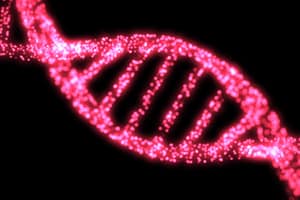 The potential for treating or preventing disease by modifying gene expression captured the imagination of the scientific community following the discovery of DNA. While the therapeutic concept of gene therapy seemed simple, the development of safe and effective therapies poses one of the greatest technical challenges in modern medicine.
The potential for treating or preventing disease by modifying gene expression captured the imagination of the scientific community following the discovery of DNA. While the therapeutic concept of gene therapy seemed simple, the development of safe and effective therapies poses one of the greatest technical challenges in modern medicine.
Gene therapy emerged in the mid-1980s with the potential to cure diseases (including inherited disorders, some cancers and certain viral infections) by replacing a mutated disease-causing gene with a healthy copy of the gene, inactivating (‘knocking out’) an improperly functioning mutated gene, or introducing a new gene into the body to help fight a disease.
Although gene therapy as a concept is a logical and straightforward approach to genetic disease, little progress has been made since the first gene therapy clinical trial began in 1990 and progress in the pursuit of effective and safe gene therapies has been subject to a number of major setbacks.
A recent positive opinion from the European Medicines Agency Committee for Medicinal Products for Human Use (CHMP) recommended marketing authorisation for alipogene tiparvovec (Glybera; uniQure) as a treatment for lipoprotein lipase deficiency (LPLD, hyperlipoproteinaemia type I), under exceptional circumstances. If marketing authorisation is granted by the European Commission, as generally follows after a recommendation from the CHMP, Glybera will become the first gene therapy product approved in Europe to treat orphan diseases (rare conditions with a high unmet medical need).
Approval may provide a significant boost to the field of gene therapy, where the early promise of curing disease at the genetic level has been elusive. While two gene therapy products are available in Asia, none have achieved marketing approval in Europe or the US.
Glybera – first therapy for LPLD?
LPLD is a very rare, inherited disease caused by mutations in the LPL gene and has no alternative treatment. Patients with LPLD are unable to metabolise chylomicrons (triglyceride-rich lipoproteins or fat particles that circulate in the blood after a meal), resulting in severe hypertriglyceridaemia and painful and potentially life-threatening inflammation of the pancreas.
Glybera utilises an adeno-associated virus delivery vector to introduce a normal, healthy LPL gene into the body, where it can make functional LPL protein. Data from three interventional clinical studies conducted in the Netherlands and Canada, and a case note review study have shown that a single dose of Glybera was effective in reducing fat concentrations in the blood in nearly all patients and resulted in long-term presence and biological activity of the LPL protein in the muscle, accompanied by a clinically significant reduction in acute pancreatitis.
Glybera was well tolerated in all studies, and no material safety concerns were observed. uniQuire is preparing to file for regulatory approval for Glybera in the US, Canada and other markets.
However, bringing Glybera this far has not been easy. In mid to late 2011, the CHMP recommended against marketing authorisation for Glybera for the treatment of LPLD. Following a request from the EC, the CHMP re-evaluated Glybera in a restricted group of patients with severe disease but subsequently maintained that Glybera should not be granted approval.
In July 2012, the CHMP finally recommended approval of the therapy in patients with LPLD and those suffering severe or multiple pancreatitis attacks.
Safety first
The safety of gene therapy approaches is vital. In the early years of gene therapy research, the risk of serious side effects was underestimated. A major wake-up call came with the death of 18-year-old Jesse Gelsinger. Jesse died in 1999 from massive immune response-mediated organ failure after receiving a high dose of an adenoviral gene therapy at the University of Pennsylvania in an experiment designed to test the safety of a treatment for ornithine transcarbamylase deficiency.
Jesse, who had a mild form of the disease, would not have benefited from the therapy, which would have ordinarily been used on babies with a fatal form of the disease. The potential carcinogenicity of some gene therapy approaches has also been raised as a concern, and much research, and greater regulatory oversight by bodies such as the US Food and Drug Administrations and the EMA, has resulted in the development of safer vectors and reduced immunogenicity.
Gene therapy in cancer
Although cancer is often associated with numerous gene mutations, making gene therapy seemingly unsuitable, cancer has been chosen as a target for a number of gene therapies, several of which have reached late-stage development or been granted approval. Gene therapy approaches used include substituting missing or altered genes to restore function and immunomodulation to stimulate the body’s natural ability to attack cancer cells or to improve the sensitivity of cancer cells to chemotherapy.
In 2004, China was the first country to approve a gene therapy product for commercial use – Shenzhen SiBiono GeneTech’s p53 gene therapy Gendicine, which is marketed in the region for the treatment of head and neck squamous cell carcinoma (HNSCC). In preregistration clinical trials, 64 per cent and 32 per cent of patients with late-stage HNSCC treated with weekly doses of Gendicine for eight weeks showed complete and partial regression, respectively.
When combined with chemo- and radiotherapy, Gendicine improved treatment efficacy more than three-fold, and no patient relapsed during more than three years of follow-up.
In contrast to a number of gene therapies, which used retroviral vector delivery systems that led to complications and a halt of further clinical trials in the US, Gendicine uses an adenoviral vector in combination with a p53 tumour suppressor gene delivery system – the only side effect being transient low grade fever.
Gendicine is very similar to Gendux/Introgen’s p53 gene therapy called contusugene ladenovec (Advexin), which was discontinued after regulatory applications for the HNSCC indication were either refused filing (in the US) or withdrawn (in the EU).
Therapies for cancer in late-stage development
Rexin-G (Epeius Biotechnologies) is a tumour-targeted injectable gene therapy vector that was approved in the Philippines in December 2007 and has since been marketed there for refractory, metastatic solid tumours. In the US, it is has been granted phase III status by the FDA for osteosarcoma and refractory metastatic breast and pancreatic cancers.
The US-based company Advantagene is developing a cancer-suicide gene therapy called Gene Mediated Cytotoxic Immunotherapy (GMCI) for the treatment of primary and metastatic disease. GMCI involves local (intratumoural) delivery of an adenoviral vector with the herpes thymidine kinase gene (AdV-tk), in combination with an oral anti-herpetic (ganciclovir or valaciclovir) and radiation therapy to synergistically kill tumour cells locally and prevent cancer recurrence by activating the patient’s immune system.
The most advanced development indication is prostate cancer, for which fast track status has been granted; the gene therapy (ProstAtak) is being tested in newly diagnosed prostate cancer in a pivotal phase III study. This same gene therapy approach is also in clinical trials for malignant gliomas (GliAtak) and pancreatic cancer (PancAtak) .
Velimogene aliplasmid (Allovectin-7; Vical) is a first-in-class, systemic DNA plasmid/lipid developed for the treatment of malignant melanoma. Intratumoural administration of velimogene aliplasmid leads to the expression of HLA B-7 and ß2 microglobulin on tumour cells, enhancing tumour antigen presentation and stimulating a cellular immune response against the tumour. Allovectin-7 is currently being evaluated in a phase III trial as a first-line therapy in malignant melanoma, primarily in the US and Europe. Data released by Vical have shown that responders to velimogene aliplasmid lived significantly longer than nonresponders.
Talimogene laherparepvec (Onco-VEX GM-CSF, BioVex) is also undergoing phase III investigation for malignant melanoma in the US, UK, Canada and South Africa. This gene therapy is an oncolytic herpes simplex type 1 virus engineered to replicate selectively in tumour cells, stimulating necrosis of the tumour and inducing an immune response against uninjected tumours.
NovaRx Corporation is also developing a non-viral gene-based allogeneic tumour cell vaccine, called belagenpumatucel-L (Lucanix), in phase III trials for treatment of advanced non-small cell lung cancer (NSCLC). Belagenpumatucel-L is made from patients’ own tumour cells that are genetically modified to express an antisense DNA molecule that binds to the transforming growth factor beta (TGFß)-producing gene and prevents its expression. TGFß helps cancer cells evade the immune system. Enrolment in the pivotal phase III STOP trial was completed in May 2012.
Phase III for non-cancer indications
Cardium Therapeutics is currently recruiting patients for a phase III study of alferminogene tadenovec (Generx; Cardionovo), for myocardial ischaemia in patients with stable angina due to coronary artery disease (ASPIRE). In this study, patients will receive a one-time administration of the adenoviral-mediated human fibroblast growth factor-4 gene transfer therapy, to assess safety and efficacy in improving myocardial perfusion, angina functional class, patient symptoms and quality of life.
Alferminogene tadenovec is designed to stimulate new blood vessel growth, providing an alternative route for blood to bypass clogged and blocked arteries in the heart. Initial studies have shown that the treatment reduces angina severity and improves myocardial perfusion in patients with heart disease.
Finally, GSK 2696273 (GSK) is an ex-vivo stem cell gene therapy that is in phase III development in the EU for treatment of adenosine deaminase severe combined immune deficiency (ADA-SCID). GSK 2696273 works by inserting the correct form of a single gene into the patient’s own stem cells derived from his or her bone marrow, via a gene transfer technology implant.
If gene therapy approaches are proven to address unmet needs in cancer and other indications effectively, we can expect a resurgence in support of gene therapy. However, overcoming regulatory barriers and the successful commercialisation of gene therapy products remain challenges for the biotechnology industry before gene therapy can fulfill its earlier promise.

The Author
Pipeline was written by Ray Hill of Adis International (Springer Healthcare), using data derived from Adis R&D Insight, Clinical Trials Insight and inThought™.
For further information on Adis services, please contact Daniela Ranzani on +39 02 423 4562 or email: Daniela.Ranzani@springer.com




